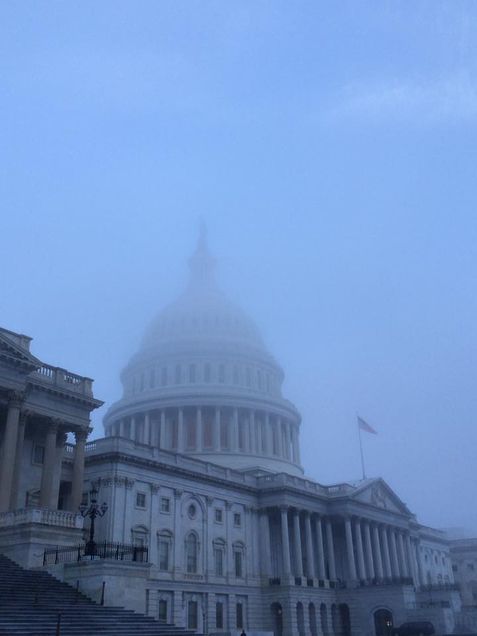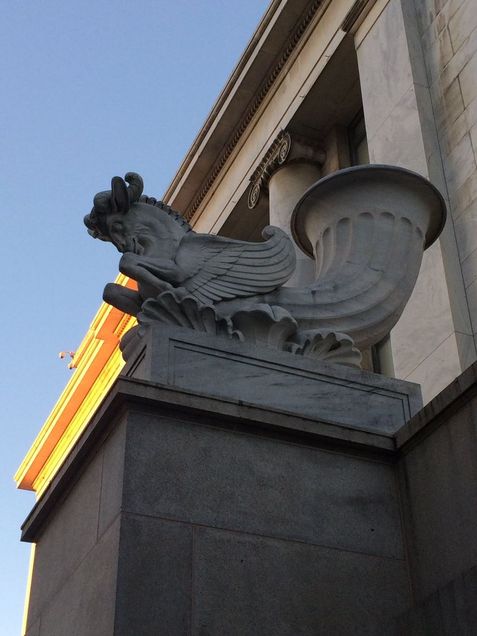Washington, D.C. – A Crossroads of Action and Adventure
by Samuel Baker (Fall 2016)
Before I attempt to reflect on my experiences in D.C. this semester, it must be noted that the Presidential election has influenced my perspective on what I have seen and on what I have done. Indeed, the primary reason I decided to spend my penultimate undergraduate semester in Washington was to witness what I believe to be a pivotal election in our nation’s history, from the standpoint of an aspiring historian, an eager student, and an engaged citizen. With that being said, anyone who visits the nation’s capital must tour the heart of our nation’s government: Capitol Hill.
Aside from the fact that I have been interning on the Hill since September, any American citizen and any international observer must take the time to explore the U.S. Capitol. Inside, visitors have the opportunity to note where the exact center of the District of Columbia is located: All they have to do is search for the compass stone located in the center of the flagstoned-floor of the Crypt. Moreover, the essential narrative of the nation’s founding is depicted in the artwork and architecture of the entire building. For instance, each of the fifty states in the Union have been allowed to contribute two statues to be displayed in various rooms of the Capitol. Some statues represent colonial and revolutionary giants, like Samuel Adams and Alexander Hamilton, while other figures portray the various personalities who have occupied the Oval Office, like Ronald Reagan (California), Gerald Ford (Michigan), Dwight David Eisenhower (Kansas), and Ulysses S. Grant (Ohio) – to name a few. However, many statues reflect the diversity of the nation, like Rosa Parks and Martin Luther King, Jr., and this diversity is represented more extensively in the paintings within the Rotunda. In the Frieze of American History, Native Americans are featured frequently and prominently; likewise, paintings circling the base of the Rotunda show the Spanish conquistador De Soto on the Mississippi River in 1541 and the Anglican baptism of Pocahontas in Jamestown, Virginia in the early 1600’s. Thus, a visit to the Capitol is an undertaking commensurate to that of time travel. Personally, the ahistorical tone of this nation’s Presidential election has worried me and frustrated me to an agonizing degree, but I can take comfort in knowing that the nation’s history is preserved where the Congress meets to conduct the business of government, one just has to see it.
While a visit to the U.S. Capitol is a requirement for everyone, on the one hand, a visit to the U.S. Botanic Garden and its conservatory is a necessity of a different nature, on the other hand. Indeed, it is a tragic irony that leading politicians running for public office are debating climate change when the U.S. Botanic Garden squats serenely in the shadow of the Capitol at the base of the Hill. Within its delicate vitreous geometric panels, curving and slanting in graceful contours, a human soul in need of reprieve from the brutal political jungle can escape into the peacefulness of a human-made, gardener-maintained biodiverse hotspot, conveniently and appropriately located in the nation’s capital. How do climate change skeptics and denialists refuse to acknowledge science when they have an ecological jewel box resting at the Capitol’s doorstep? According to a recently-released documentary, Before the Flood, there are 38 Republican Senators and 131 Republican Congressmen in the 114th Congress who deny climate change. Yet, plant species from around the globe are concentrated within the conservatory in a staggering arrangement of complexity, variety, and intricacy. Indeed, if flowers could talk and plants walk, there would be vegetation agitation each day a politician, whose campaign was funded by a fossil fuel special interest, opened his mouth to deny the truth behind the enormous environmental challenge the planet and humankind face. Perhaps, the inauguration of any new lawmaker should involve a visit to the Garden and the conservatory in order to see the critically endangered and rare species thriving in that isolated, enclosed space. Beyond the bountiful beauty to the eye, the mind must consider a more sober burden: How can policies enable species on the brink of extinction to survive and thrive in their natural ecosystems without humans having to replicate the U.S. Botanic Garden around the globe?
Samuel is a senior at Boston University studying U.S. history and interned on Capitol Hill in the U.S. House of Representatives.



